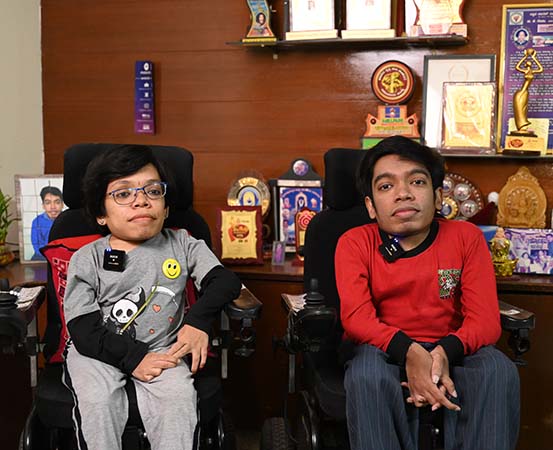
Two wheelchair-bound siblings, Jayanth K Gowda (30) and his sister Rekha K Gowda (28), who are both techies, exchange a warm smile as they provide tuition to neighbouring kids at their home. They are living with Morquio syndrome, a rare complication which affects their mobility. The crippling condition, however, cannot take away their zeal to live.
What keeps them going? “We were very much influenced by the motivational stories that our father told us in our childhood. He made us feel no different from other kids,” they recall.
READ MORE :
How personal battles prompted families to set up rare diseases group
All about Wiskott-Aldrich syndrome
Morquio syndrome, also known as Mucopolysaccharidosis type IVA, is a rare metabolic disorder where the body cannot process certain type of sugar molecules.
The two siblings work as software engineers in an IT company in Bengaluru. Rekha says that their wheelchair does not stop them from living like anyone else. “Our parents sent us to a regular school to make us feel included and study like any other child. There were challenges due to our underlying condition. We were neither as tall as other children, nor we could lift our bags and walk on our own. But people around us have always been kind enough to help us,” she says.
When Happiest Health met the duo at their Bengaluru home, they recalled how they were diagnosed with the disease. “It was a run from pillar to post for my parents to know why I was not moving like other kids of my age,” Jayanth told Happiest Health.
In Jayanth’s case, his spinal growth was slow and he had delayed motor skills. He was initially misdiagnosed with rickets, and the treatment given for that had already worsened his condition. He was two years old when he got diagnosed with Morquio syndrome in 1995. That’s when his parents first heard the word ‘rare disease’. Word of caution to the parents was that Jayanth’s siblings would also suffer from the same condition, which further came as a shocker as his young sister Rekha was born the same year. “We learnt that she too would have the same condition and there was no way to prevent it,” he says.
Dr Meenakshi Bhat, senior faculty at Center for Human Genetics, Bengaluru, says that affected children face bone development issues over a period lasting several months (not immediately after birth). “These bony changes affect all the other bones in the body and get progressively worse. Affected individuals have normal intelligence, corneal clouding, heaviness of face called coarse facies, cardiac valve involvement as well as spine and gait issues,” she explains.
Lending a helping hand
Rekha recalls that her friends and parents helped the duo during school and college days. “With their encouragement, we got trained in Carnatic music and love to play instruments,” she says.
Jayanth says that when he graduated, his sister was still studying and he had to give up on a job opportunity so that they both could join the same company once she completed her education. He says, “She too gave up the offers that she received after graduating and made it a point to join the company where they were ready to take both of us in. We gave our interviews and got in.”
What causes Morquio syndrome?
Dr Bhat says that the syndrome is caused by the absence or decreased function of an enzyme called GALNS (N-acetyl-Galactosamine-6-sulfatase) in the body. “This enzyme plays an important part in bone and cartilage growth. Each parent carries one copy of the mutated gene. For parents of one affected child, the recurrence risk is one in four for every subsequent pregnancy,” she says.
Jayanth faced issues with eyesight and hearing when he was in school. “As they had experience with my case, my parents were alert and prepared to tackle the same for my sister,” he said.
Diagnosis of Morquio syndrome
Dr Bhat says that Morquio syndrome is caused by the mutation of a single gene and the carriers of an affected individual can be identified through a gene sequencing test. “If both parents are confirmed carriers of MPS IVA, pregnancy tests can be offered to the mother at around 11-12 weeks of pregnancy. Direct sampling of the developing placental tissue and checking it for the familial gene mutation will confirm if the pregnancy is affected or not,” she explains.
Treatment
Talking about the treatment, Dr Bhat says, “Enzyme replacement therapy (ERT) has been available in other countries since the last few years. ERT should be ideally started before extensive skeletal involvement has occurred. It is very expensive and is given as a weekly intravenous infusion all throughout life. In India, this medicine is not easily available as it must be imported and has not yet secured regulatory approvals.”
She says that affected individuals in India can undergo comprehensive supportive management therapies in specialised centres to minimise the complications of the disorder.
Takeaways
- Morquio syndrome can be diagnosed through a gene sequencing test.
- Affected individuals have normal intelligence, heaviness of face as well as spine and gait issues.
- For parents of one affected child, the recurrence risk is one in four for every subsequent pregnancy.
















